Smart Investor: How to use US index options to manage volatility during the US elections: a beginner's guide
Options are complex, high-risk products and require knowledge, investment experience and, in many applications, high risk acceptance. We recommend that before you invest in options, you inform yourself well about the operation and risks.
How to use US index options to manage volatility during the US elections: a beginner’s guide
Introduction
As we approach the 2024 US elections, markets are bracing for potentially significant volatility, driven by the uncertainty of the outcome. According to an analysis in this Saxo article, two key election scenarios are expected to trigger the most immediate positive or negative market reactions:
- A Democratic sweep, which could have a negative effect on markets due to anticipated corporate tax hikes and increased regulation.
- A Harris gridlock, which could result in a market-friendly outcome as significant policy changes would be harder to pass, though the reaction might be more muted.
These scenarios present both risks and opportunities for investors. Whether you need to protect your portfolio from sharp market declines or take advantage of heightened volatility, US index options (such as SPX, NDX, and RUT) offer strategic tools to navigate the uncertainty.
In this article, we will explore how you can use index options to:
- Hedge against potential market drops (e.g., in the case of a Democratic sweep).
- Profit from election-related volatility by using option strategies like calls and credit spreads.
1. What are index options?
Index options provide a way to trade or hedge broad stock market indices, such as the S&P 500 (SPX), NASDAQ-100 (NDX), and Russell 2000 (RUT). These options are cash-settled based on the index level at expiration, meaning there is no need to hold or exchange physical shares of an underlying asset.
While ETF options on products like SPY and QQQ are also commonly used to trade broader indices, index options offer certain advantages:
- Cash-settled: No need to exchange or manage shares, reducing complexity.
- Larger notional value: Index options typically have a larger notional value, making them more efficient for managing large portfolios or broader exposure.
For these reasons, index options are often the preferred choice for traders looking to hedge or profit from major market moves during high-impact events like the US elections.
2. Why are elections volatile, and how can index options help you cover this volatility?
US elections introduce significant uncertainty over future policies, and this can drive large price swings in the markets. For example, a Democratic sweep could lead to a negative market reaction due to concerns over corporate tax hikes, while a Harris gridlock may trigger a more positive response from markets.
How can index options help cover volatility?
- Hedging Against Market Drops: One effective way to protect your portfolio from a market downturn following the election is by using protective puts. Buying put options on indices like SPX, NDX, or RUT allows you to offset potential losses if the market drops.
- Profit from Price Swings: On the other hand, if you expect the market to react favorably, you can use strategies like long calls or put credit spreads to benefit from a rising market while controlling risk and cost.
Important note: the strategies and examples provided in this article are purely for educational purposes. They are intended to assist in shaping your thought process and should not be replicated or implemented without careful consideration. Every investor or trader must conduct their own due diligence and take into account their unique financial situation, risk tolerance, and investment objectives before making any decisions. Remember, investing in the stock market carries risk, and it's crucial to make informed decisions.
3. Basic strategies to manage election volatility using index options
A. Hedging your portfolio with puts
Election results often introduce significant market volatility. If you're concerned about a negative reaction following the U.S. elections, one effective way to protect your portfolio is through options strategies, specifically with puts.
Protective Puts:
A protective put is one of the simplest ways to hedge your portfolio. It involves purchasing a put option on an index (e.g., SPX, NDX, RUT). Should the market drop following the election, the value of the put option will rise, offsetting some or all of the losses in your broader portfolio.
For instance, if your portfolio is valued at around $100,000 and you expect a possible 5% drop in the S&P 500 (around 290 points from the current level of 5,800), buying a simple out-of-the-money put at a strike price of 5,510 would offer protection. However, this strategy has a cost. As seen in the options chain, purchasing a 5,510 strike SPX put expiring on November 15th costs about $3,230 (32.30 * 100), implying a break-even level of 5,477.70 (strike price minus premium). For this protective option to pay off, the S&P 500 would need to drop more than 5% before you start realizing profits.
Given the cost, this strategy could be considered inefficient if the index doesn't fall far enough or declines moderately.
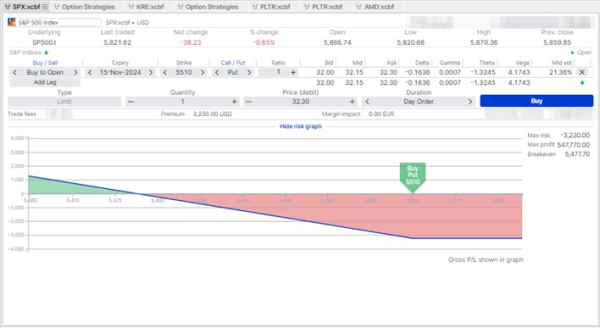
Put debit spread: a more cost-effective protection
To optimize this hedging approach, you can consider a put debit spread, which provides downside protection at a reduced cost. This strategy involves buying a put with a strike price closer to the current index level, but then selling a lower-strike put to help offset the cost.
For example, instead of buying the 5,510 strike put outright, you could purchase a higher strike put (e.g., 5,600) and sell a 5,500 strike put. The net cost of this spread is significantly lower at $1,220 ($12.20 * 100) compared to the $3,230 cost of the standalone put.
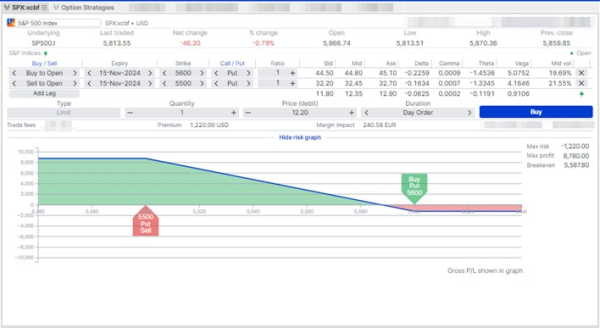
While this approach limits your maximum profit to the difference between the two strikes (i.e., $10,000 – $1,220 = $8,780), it still offers sufficient protection for a 5% market drop. In this scenario, the maximum profit would be realized if the S&P 500 falls to or below 5,500 by expiration. Since you don’t expect a drop deeper than 5%, this trade balances affordability with effective downside protection.
B. Profiting from an upside movement: calls and credit spreads
Election results don’t just trigger market downturns; they can also result in sharp upward movements if the market reacts favorably. One straightforward way to profit from such a scenario is to buy a long call option, which allows you to benefit from a rising market.
Long call:
Buying a call option gives you the right, but not the obligation, to purchase the index at a specific price (the strike price) before the option expires. For instance, in the attached example, buying a 5,800 strike SPX call expiring on November 15th costs a premium of $12,910 ($129.10 * 100). This option allows you to profit if the S&P 500 rises significantly.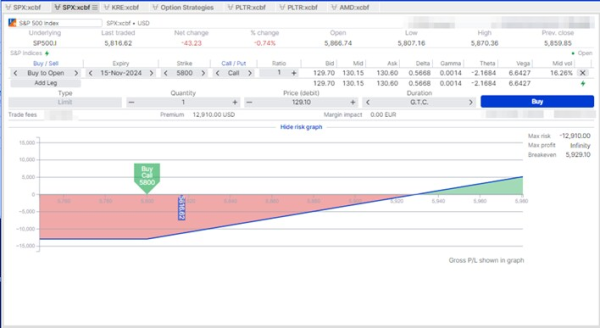
However, the break-even point for this call option is 5,929.10, meaning the S&P 500 would need to surpass that level before you start realizing profits. Given that the market is currently trading at around 5,800, it would require a substantial upswing to make this trade worthwhile before expiration. While it’s possible, this is a highly speculative trade with considerable cost upfront.
So, what if we want a strategy that increases our probability of profit while reducing the upfront cost?
Put credit spread:
Instead of relying solely on a long call, a put credit spread offers an alternative, more probability-driven way to profit from an upward move. This strategy involves selling a put with a higher strike price and simultaneously buying a put with a lower strike price. The goal is to collect the net premium from the trade, which would be profitable as long as the index stays above the higher strike price.
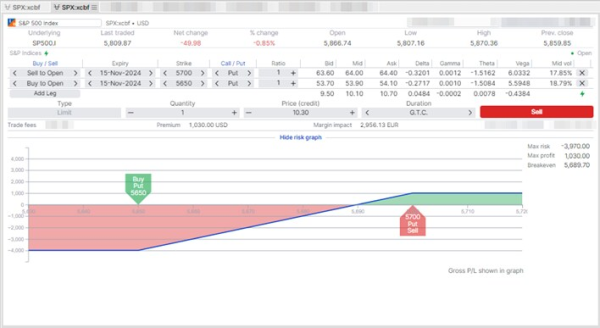
In the attached example of the put credit spread, you sell a 5,700 strike put and buy a 5,650 strike put, both expiring on November 15th. Here’s how this strategy works:
- You receive a net premium of $1,030 ($10.30 * 100) by selling the 5,700 put and buying the 5,650 put.
- The maximum risk is $3,970 ($5,000 strike difference - $1,030 premium received).
- The maximum profit is the premium collected: $1,030.
- The break-even point is 5,689.70 (higher strike minus premium received).
In this case, as long as the S&P 500 stays above 5,700, you keep the full premium and make your maximum profit of $1,030. If the market does drop below 5,700, the loss is capped at $3,970, which is significantly lower than the risk involved in the long call strategy.
By implementing the put credit spread, you take advantage of the expectation that the market will stay neutral to positive after the election, while limiting the capital at risk compared to a pure long call option. It’s a more probability-driven strategy, offering a better risk-reward profile for a potential election-related market surge.
4. Timing is crucial: when to implement these strategies
- Pre-election: As election day approaches, implied volatility rises, increasing option prices. This is the ideal time to implement protective puts or credit spreads to hedge or profit from the expected volatility.
- Election night and post-election: For traders looking to capitalize on short-term volatility, election night can offer sudden market swings. Zero DTE (days-to-expiration) options allow you to capture rapid price changes during this time, but they carry significant risk.
5. Key risks to keep in mind
- Implied volatility risk: Higher volatility makes options more expensive. If the market doesn’t move as much as expected, you could lose the premium paid for the options, especially in strategies like long calls or protective puts, where substantial movement is required for profitability.
- Expiration risk: Options have a finite lifespan. If the market doesn’t move before the options expire, they may lose their value. Timing trades around key events such as debates, election day, or polling results is essential to maximize the effectiveness of your strategies.
- Limited upside with spreads: Strategies like put debit spreads and put credit spreads limit both your maximum risk and potential profit. While these strategies are cost-effective, they cap the upside, so choosing appropriate strike prices and understanding the risk-reward balance is critical.
6. Available index options on our platform
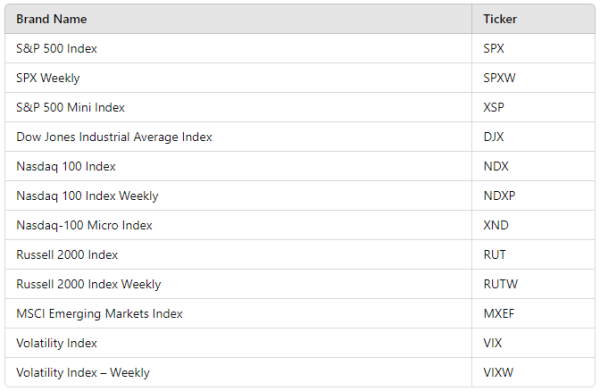
Note on liquidity and spreads
While these index options offer broad market exposure and effective tools for managing volatility, it's important to note that some of these products may have wider bid-ask spreads. A wide spread can indicate lower liquidity, meaning there are fewer buyers and sellers actively trading the product. This can make it costly to enter and exit trades, as the price difference between buying and selling can be substantial. In such cases, trading these options may not always be viable, as the costs associated with the spread can reduce or eliminate potential profitability.
Conclusion
The upcoming US elections present both risks and opportunities for traders. By using index options like SPX, NDX, and RUT, you can hedge your portfolio, capitalize on price swings, or profit from election-driven volatility. Understanding strategies like protective puts, put debit spreads, long calls, and put credit spreads can help you navigate the uncertainty surrounding the election season. With these tools, you’ll be better equipped to manage market volatility confidently and strategically.
| Check out these guides and case studies: |
|---|
| In-depth guide to using long-term options for strategic portfolio management Our specialized resource designed to learn you strategically manage profits and reduce reliance on single (or few) positions within your portfolio using long-term options. This guide is crafted to assist you in understanding and applying long-term options to diversify investments and secure gains while maintaining market exposure. |
| Case study: using covered calls to enhance portfolio performance This case study delves into the covered call strategy, where an investor holds a stock and sells call options to generate premium income. The approach offers a balanced method for generating income and managing risk, with protection against minor declines and capped potential gains. |
| Case study: using protective puts to manage risk This analysis examines the protective put strategy, where an investor owns a stock and buys put options to safeguard against significant declines. Despite the cost of the premium, this approach offers peace of mind and financial protection, making it ideal for risk-averse investors. |
| Case study: using cash-secured puts to acquire stocks at a discount and generate income This review investigates the cash-secured put strategy, where an investor sells put options while holding enough cash to buy the stock if exercised. This method balances income generation with the potential to acquire stocks at a lower cost, appealing to cautious investors. |
| Case study: using collars to balance risk and reward This study focuses on the collar strategy, where an investor owns a stock, buys protective puts, and sells call options to balance risk and reward. This cost-neutral approach, achieved by offsetting the cost of puts with the premiums from calls, provides a safety net and additional income, making it suitable for cautious investors. |
| Previous "Investing with options" articles |
|---|
|
| "Saxo Options Talk" podcast |
|
| Other related articles |
|
| Why options strategies belong in every trader's toolbox |
| Understanding and calculating the expected move of a stock ETF index |
| Understanding Delta - a key guide for Investors and Traders |
|
Options are complex, high-risk products and require knowledge, investment experience and, in many applications, high risk acceptance. We recommend that before you invest in options, you inform yourself well about the operation and risks. In Saxo Bank's Terms of Use you will find more information on this in the Important Information Options, Futures, Margin and Deficit Procedure. You can also consult the Essential Information Document of the option you want to invest in on Saxo Bank's website.